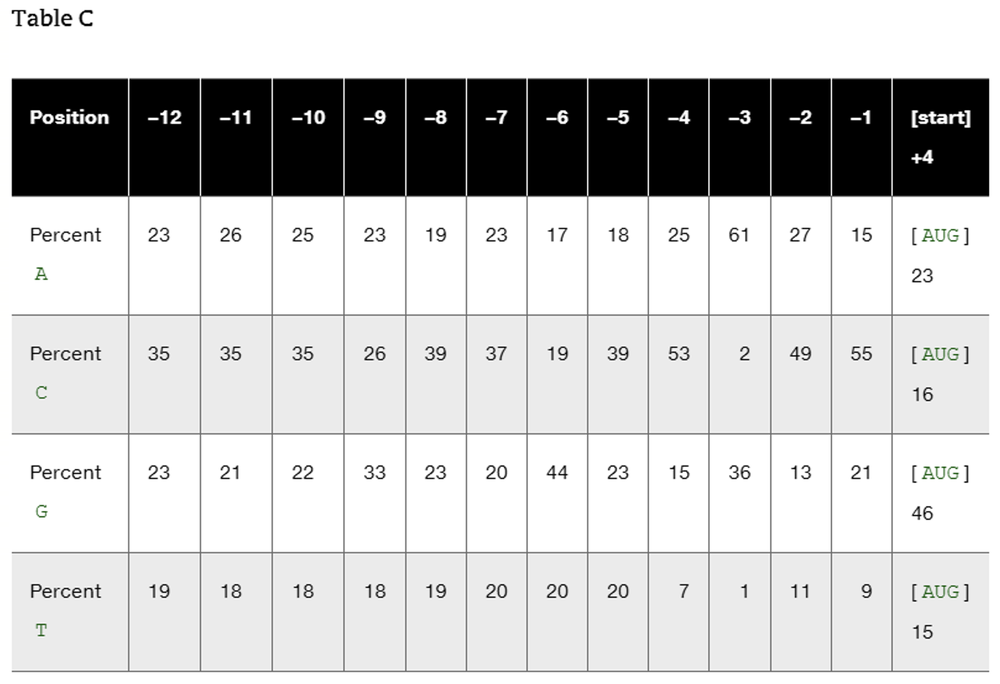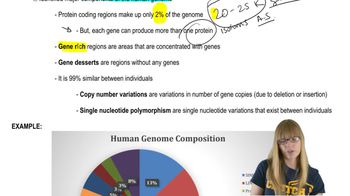Explain why the one-gene:one-enzyme concept is not considered totally accurate today.
Table of contents
- 1. Introduction to Genetics51m
- 2. Mendel's Laws of Inheritance3h 37m
- 3. Extensions to Mendelian Inheritance2h 41m
- 4. Genetic Mapping and Linkage2h 28m
- 5. Genetics of Bacteria and Viruses1h 21m
- 6. Chromosomal Variation1h 48m
- 7. DNA and Chromosome Structure56m
- 8. DNA Replication1h 10m
- 9. Mitosis and Meiosis1h 34m
- 10. Transcription1h 0m
- 11. Translation58m
- 12. Gene Regulation in Prokaryotes1h 19m
- 13. Gene Regulation in Eukaryotes44m
- 14. Genetic Control of Development44m
- 15. Genomes and Genomics1h 50m
- 16. Transposable Elements47m
- 17. Mutation, Repair, and Recombination1h 6m
- 18. Molecular Genetic Tools19m
- 19. Cancer Genetics29m
- 20. Quantitative Genetics1h 26m
- 21. Population Genetics50m
- 22. Evolutionary Genetics29m
11. Translation
Translation
Problem 34
Textbook Question
Table C contains DNA-sequence information compiled by Marilyn Kozak (1987). The data consist of the percentage of A, C, G, and T at each position among the 12 nucleotides preceding the start codon in 699 genes from various vertebrate species and at the first nucleotide after the start codon. (The start codon occupies positions +1 to +3 and the first nucleotide immediately after the start codon occupies position +4) Use the data to determine the consensus sequence for the 13 nucleotides ( -12 to -1 and +4) surrounding the start codon in vertebrate genes.

 Verified step by step guidance
Verified step by step guidance1
Step 1: Understand the problem. The goal is to determine the consensus sequence for the 13 nucleotides surrounding the start codon in vertebrate genes using the provided data. A consensus sequence represents the most common nucleotide at each position across multiple sequences.
Step 2: Analyze the data in Table C. For each position (from -12 to +1 relative to the start codon), calculate the frequency of each nucleotide (A, C, G, T). Identify the nucleotide with the highest percentage at each position.
Step 3: Construct the consensus sequence. For each position, select the nucleotide with the highest frequency from the data. Combine these nucleotides sequentially to form the consensus sequence spanning positions -12 to +1.
Step 4: Verify the sequence. Ensure that the selected nucleotides accurately reflect the highest frequency at each position and confirm that the sequence aligns with the start codon (positions -3 to -1 should correspond to the start codon, typically AUG in mRNA).
Step 5: Interpret the results. Discuss the biological significance of the consensus sequence, such as its role in translation initiation and how it may vary across vertebrate species.
 Verified video answer for a similar problem:
Verified video answer for a similar problem:This video solution was recommended by our tutors as helpful for the problem above
Video duration:
3mPlay a video:
Was this helpful?
Key Concepts
Here are the essential concepts you must grasp in order to answer the question correctly.
Consensus Sequence
A consensus sequence is a sequence of DNA that represents the most common nucleotide at each position across a set of sequences. It is derived from multiple sequences and highlights the nucleotides that are most frequently observed, providing insights into functional elements such as promoters or start codons. In this context, the consensus sequence will help identify the typical nucleotides surrounding the start codon in vertebrate genes.
Recommended video:
Guided course

Sequencing Overview
Start Codon
The start codon is a specific nucleotide triplet in mRNA that signals the beginning of translation, typically AUG, which codes for the amino acid methionine. It is crucial for the proper initiation of protein synthesis. Understanding its position and the surrounding nucleotides is essential for analyzing gene expression and the translation process in vertebrates.
Recommended video:
Guided course

Translation initiation
Nucleotide Composition
Nucleotide composition refers to the relative abundance of the four nucleotides (adenine, cytosine, guanine, and thymine) in a given DNA sequence. Analyzing the nucleotide composition at specific positions can reveal patterns that are important for gene regulation and function. In this case, it helps in determining the consensus sequence by examining the frequency of each nucleotide around the start codon.
Recommended video:
Guided course

Human Genome Composition

 7:58m
7:58mWatch next
Master Translation initiation with a bite sized video explanation from Kylia
Start learningRelated Videos
Related Practice
Textbook Question
980
views
